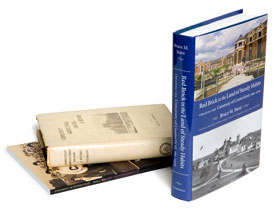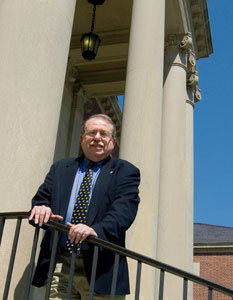  |
| HOME | THIS ISSUE | CALENDAR | GRANTS | BACK ISSUES | < BACK | NEXT > |
Stave’s new book on UConn history celebrates 125th anniversary- September 5, 2006 |
||||
| A new history of UConn has been published recently as part of the University's 125th anniversary celebration. The book - Red Brick in the Land of Steady Habits: Creating the University of Connecticut, 1881-2006 - was written by Bruce Stave, Board of Trustees Distinguished Professor of History Emeritus and director of UConn's Center for Oral History. He was assisted in his research by three UConn graduate students - Laura Burmeister, Michael Neagle, Leslie Horner Papandrea - and his wife, Sondra Astor Stave. Stave discussed the book with Mark J. Roy, author of University of Connecticut, a photographic history of UConn; and Ken Best, editor of UConn Traditions .
Q: What were you trying to convey in doing this updated history? A: Historians try to develop analytical narrative, but with this particular project I wanted it to be readable, so that a wide public would be able to appreciate and enjoy the history of the University of Connecticut. There was a very good book written by Walter Stemmons in 1931 for the University's 50th Anniversary. I tried to emphasize the history of the University subsequent to that, the period from the mid 1930s to the present. Q: What were the challenges in researching the history? A: To be able to synthesize an enormous amount of material. The book is primarily archivally based. The archives are in the Thomas J. Dodd Research Center. Each one of the presidents' files has been collected, and they are all in the archives, except for Harry Hartley, although I did a seven-hour oral history with him, and he also prepared an account of UConn 2000. But the other files are just enormous. Archivists talk about linear feet, and there are boxes and boxes, and each box has files, and each file could have a hundred documents in it. So the task was to be able to get a handle on that. Q: Did you find any documents that offered some unique insights into the University's history? A: Albert Waugh came to the University in 1924 as an economic statistician and worked his way up to head of the economics department, dean of arts and sciences, and then to provost. He retired in 1965, but from 1941 to 1969, he kept a journal on a daily basis and there are 13,000 pages in it. A journal is enormously helpful to a historian. I made an early determination that it was honest. Sometimes you have to be careful with these kinds of sources. They may be self-promoting or grinding an axe. His was self-critical.
A: One I think of particularly had to do with the McCarthy Era in the 1950s, when Waugh explains how President Jorgensen and he were called in to meet Gov. John Lodge, who was very anti-communist and wanted to get rid of the faculty who were accused of being communists. Lodge wanted to fire them himself, and Jorgensen - who felt pressured by the board and did question faculty about their sympathies - had to explain that it was the trustees, and not the governor, who had the power to fire faculty. Essentially Lodge is getting angrier and angrier and you have this portrayed in Waugh's diary. The journal provides the "inside" story - what went on behind closed doors. Q: Were you surprised by anything you found during your research? A: One surprise was the critical role that someone like Waugh played for the development of the institution.
Q: In reading the book, 1935 stands out as a pivotal year, when Charles McCracken leaves and Albert Jorgensen becomes president. A: Yes. McCracken was, unfortunately, not a successful president. I don't think he had much vision for the institution. Jorgensen did have a vision of turning the University into a large state university in the midwestern model. And so, yes, his coming is certainly important. He comes up with the building plan almost immediately, and he gets a lot of what he wants from the legislature by 1939. This is at the time of the Depression. So his impact cannot be minimized. Unfortunately he stayed a little too long, because all of the good that he does ends. The faculty is against him. The students are against him. The governor is against him. So by the end, it's a no-win kind of situation for him. Q: There were clearly several major historical events that affected the University's growth and its development. Which one had the greatest effect? A: Clearly World War II had a major effect because it brought soldiers onto campus. They were trained here. The war also gave women the opportunity for education that they did not have before. For the first time, women became the majority of the student body, and they took on positions of authority. But the major effect I think was what happened afterward with the GI Bill. The Fort Trumbull campus is set up in the Groton area, veterans come back, and the school begins to explode in numbers of people who are here. This is when it really becomes a university. This is not different than many other places across the country, but the University's mission also changed. You begin to get a shift by 1949, when the first Ph.D. is awarded. I also think the cultural change that went on in the 1960s was highly significant, because it shifts the whole way you look at students, ending in loco parentis [the University's acting in place of parents], and it also tested the notions of academic freedom and liberalism on campus. Q: Was there a critical point where a decision was made or events happened that are still impacting UConn today? A: I really think the change that's come to the institution in the past 10 to 15 years has been enormous. That's not being myopic and saying I'm only looking at the recent history. I'm looking at the whole long history. The changes in the last 10 to 15 years of creating a national university really made a difference, because from the very beginning there was a tension here between moving from an agricultural and technical school to one with a broader focus on liberal arts and sciences. Moving to a comprehensive institution, a broader research institution, that tension carried through for many, many years. I don't think it still exists today. People have accepted the fact that this is a major research institution with a national reputation. Q: What do you want readers to come away with from the book? A: I hope they get a lively sense of how an institution of higher education, particularly this institution, develops and why it is the way it is. The tendency is for people to think their period is the critical era. But I hope that people will have an appreciation for the growth of the institution, and read it from start to finish. Red Brick in the Land of Steady Habits is available at the UConn Co-op and other booksellers. |
| ADVANCE HOME UCONN HOME |

 Q: Can you give an example of a particularly helpful section of the journal?
Q: Can you give an example of a particularly helpful section of the journal? 